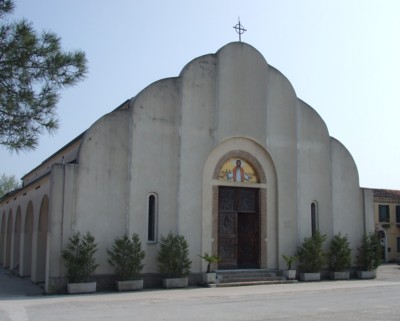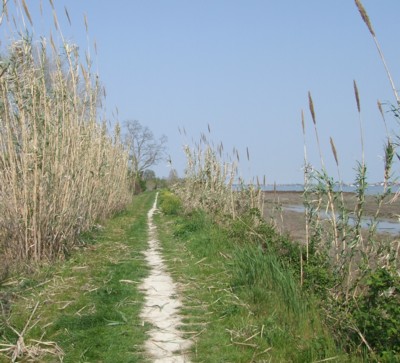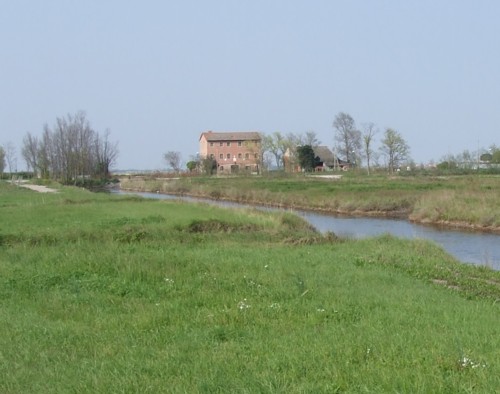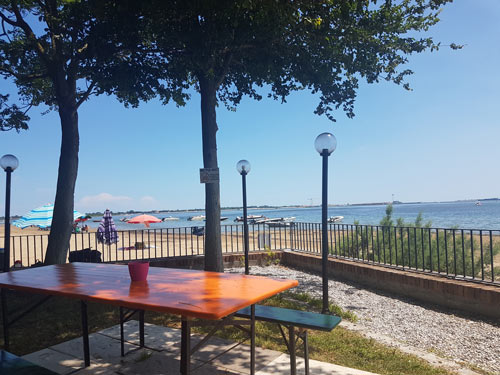The Isola di Sant’Erasmo (St. Erasmus) is the largest island in the Venetian lagoon, though it’s only sparsely populated. For years this has been Venice’s countryside, the agricultural zone which produces the fruit and vegetables consumed by the hungry city. Among its produce, particularly renowned are the artichokes (carciofi). The landscape is flat, and dotted with farms and rural small-holdings. It couldn’t be more different from Venice, whose bell-towers and churches can be seen on the skyline.
Travel
The Sant’Erasmo ferry is the number 13 which departs from Venice’s Fondamente Nove stop on a roughly hourly basis. The boat calls at three stops along the shore of Sant’Erasmo: Capannone, then Chiesa, and finally Punta Vela. The journey takes 30-50 minutes, depending on which stop you get off at. Note that not all the services run the full route; check a timetable. It’s also advisable to note the return times before you set off to explore the island.
In the summer months, a ‘bathing’ service, the number 18, connects the Lido with Murano via Sant’Erasmo. This is a scenic journey, and the ferry stops right by the bar and beach on Sant’Erasmo at the Torre Massimiliana.
Walking around the island
The island is a long strip of land running from the south-west to the north-east. The three main ferry stops are all on the north-western ‘inner’ shore, looking over the lagoon rather than towards the sea. This long stretch faces across the water and mudbanks towards the islands of Burano, whose coloured houses can just be distinguished, and San Francesco del Deserto. One of the island’s only notable buildings, the church, is on this shore. Another, the Torre Massimiliana, is down in the bottom corner of the island. This building is a nineteenth-century fort surrounded by a stagnant moat, started by the Napoleonic regime and finished by the Austrian. Its name recalls a time when Archduke Maximilian (Massimiliano) took refuge here. Recently the fort was restored and it is now open to the public, housing occasional exhibitions (opening days are limited).

It’s hard to find a map of Sant’Erasmo. If you ask at one of Venice’s tourist information offices, you may be able to find a leaflet on the northern lagoon (Laguna Nord). Even if it’s in Italian, the little charts will help you work out the geography. If you want to head straight to the old fort and refreshments, hop off the boat at Capannone and follow the road heading back towards the far shore. For a recommended walk, stay on until Chiesa and then follow the route we took (see below).
The interior of the island is covered with agricultural land, farms and houses, all carefully fenced off from the roads. To explore the island, you’ll have to walk along Sant’Erasmo’s road network. This consists of quiet rural lanes – obviously with such a small population there isn’t much traffic. Presumably cars and scooters have to be brought here on special boat delivery services, and are then left to decay. Cycling is a popular activity for visitors to the island; the roads are all flat and it’s a quick way to get about. Paths run along much of the shore: read on for our account of our trip to Sant’Erasmo.
Our walking tour of Sant’Erasmo
We got off the boat at Chiesa, the stop by the island’s church. This is one of the island’s landmarks, but it’s a fairly recent building with nothing to grab the visitor’s attention. We then set out along a lane next to the church, which headed across the width of the island, away from the northern lagoon shore. This route passed various allotments and fields, a new housing development, and Sant’Erasmo’s little cemetery. A farmer, stripped to the waist, laboured in one field, while another buzzed past in a little Ape (one of those tiny three-wheeled lorries) with his mother squeezed in next to him.

Reaching the other side of the island in a few minutes, we turned right and continued for a short distance before we came to a path leading out to the shore of the lagoon, where a comfortable track led along a bank. Down to our left were picturesque mud flats and shallow lagoon waters, where three people were wading in search of some delicacy for supper. Even on a peak holiday (Easter Monday) this part of the island was quiet – for whole stretches of the shore path we didn’t see anyone. The views over towards the mouth of the lagoon were interestingly dotted with boats and sandbanks; inland we passed more fields and gardens. Several battered rowing-boats were drawn up on the mud below us, and a couple of wading birds strutted about in a pool of water. If you’re interested either in boats or birds, it would be a good idea to bring binoculars on this excursion.
Finally, as we approached the tip of the island and the restored fort, we came upon hordes of Italian day-trippers, obviously not very keen to leave the vicinity of their fellow-Venetians or of the humble little bar-trattoria. Some – children and adults – were doing their best to pretend the muddy slope leading into the water was a proper beach. Gaggles of little boats had pulled up for socialising and refreshments. The bar, mostly peopled by old men speaking an indecipherable dialect, made a welcome break with its cheap wine and pleasant outdoor tables.
From the fort behind the restaurant, a small road leads back, past canals and ditches, towards the ferry stop of Capannone. The outing – including a break for refreshments – took us around an hour and three-quarters.
Refreshments
On the corner of the island in the shade of the Torre Massimiliana fort is the basic bar-trattoria, Bar dei Tedeschi, where we paused during our walk. Here you can eat simple meals ordered at the counter – including pizzas in summer – or drink wine for €1 a glass at rickety painted tables overlooking the lagoon.
The shore path along the southerly side of the island offers good resting-places for picnics, if you bring a rug to sit on. Close to the Torre Massimiliana there is a proper picnic spot with tables.
Accommodation and cycle hire
If you are desperate for a quiet base, you could try staying on Sant’Erasmo. There is a B&B on the island, called Il Lato Azzurro, which also rents out bicycles (get off at the Capannone boat stop, and walk for ten minutes down via Forti).

A longer island trip
If you are visiting on a Saturday or Sunday you could combine Sant’Erasmo with a guided tour of the little quarantine island over the water from the Capannone stop, Lazzaretto Nuovo. The 13 ferry also calls at Le Vignole, before it reaches Sant’Erasmo.
> More islands in the Venetian lagoon
On this site
